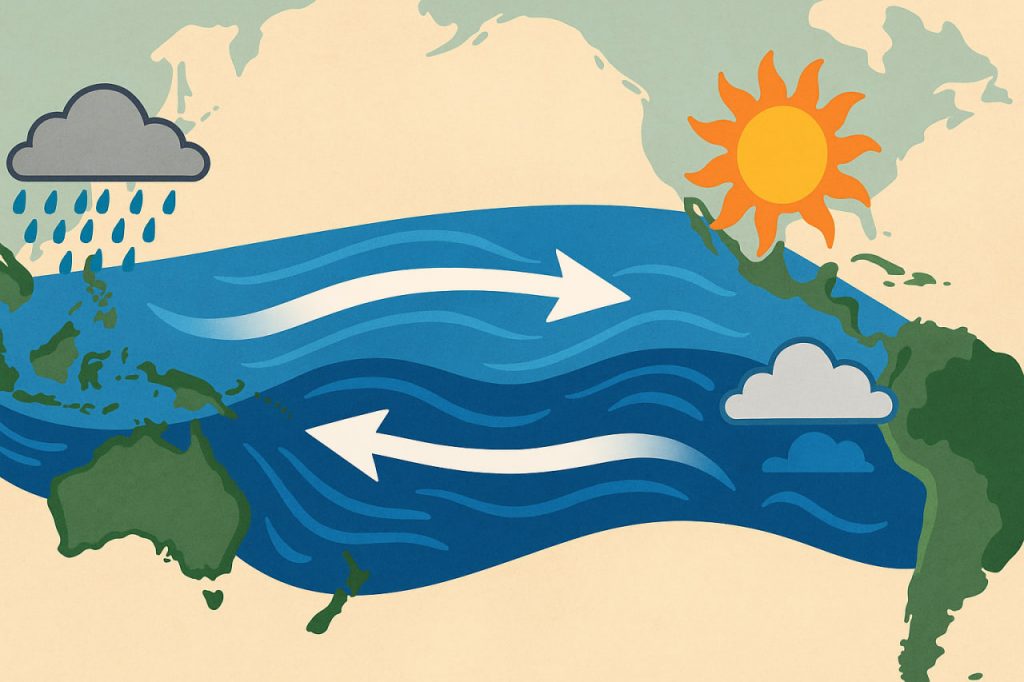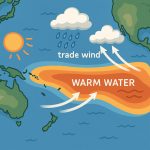La Niña is a natural climate pattern that affects weather and ocean conditions around the world. It is part of the El Niño–Southern Oscillation (ENSO) cycle and represents the cool phase of this global climate system. La Niña events can shift rainfall patterns, intensify hurricanes, and trigger temperature anomalies across multiple continents. Understanding how La Niña works is key to improving long-term weather forecasting and disaster preparedness.
How La Niña Forms
Under normal conditions, trade winds blow from east to west across the tropical Pacific Ocean, piling warm water near Australia and Indonesia. This allows cold, nutrient-rich water to rise along the west coast of South America through a process called upwelling.
During a La Niña event, trade winds become even stronger than usual, pushing warm surface water further west. This intensifies upwelling and leads to cooler-than-average sea surface temperatures in the central and eastern Pacific Ocean. These temperature shifts disrupt atmospheric circulation patterns on a global scale.
Weather Effects of La Niña
La Niña affects weather across much of the world. In Southeast Asia, Australia, and parts of Africa, it often brings above-average rainfall and an increased risk of flooding. In contrast, the west coast of South America may experience drier-than-normal conditions.
In North America, La Niña typically causes colder and wetter winters in the Pacific Northwest and warmer, drier conditions in the southern United States. It can also lead to stronger Atlantic hurricane seasons, as cooler Pacific waters reduce wind shear, which otherwise weakens hurricanes.
La Niña vs. El Niño
La Niña is the opposite of El Niño, the warm phase of ENSO. While La Niña is associated with strengthened trade winds and cooler Pacific waters, El Niño involves weakened trade winds and warmer waters in the eastern Pacific.
The global effects of La Niña and El Niño are often mirror images, but both can be equally disruptive. They do not occur on a fixed schedule, but La Niña typically lasts 9 to 12 months, sometimes even up to two years.
Impacts on the Environment and Economy
La Niña influences agriculture, fisheries, energy markets, and ecosystems. For example, increased rainfall can benefit some crops in Southeast Asia while causing flooding disasters in others. In South America, La Niña may hurt fishing industries by altering the distribution of marine species.
Ecologically, cooler ocean waters promote marine productivity, but excessive changes in temperature or rainfall can stress coral reefs, forests, and wildlife. Economically, La Niña-related disasters can cost billions in damages and lost agricultural output, especially in vulnerable regions.
Monitoring and Forecasting La Niña
Scientists monitor La Niña by using satellites, buoy networks, and oceanic sensors that record sea surface temperatures, wind speeds, and air pressure. Climate models then simulate how these variables evolve over time to make seasonal predictions.
Thanks to global climate monitoring efforts, forecasters can now detect the early stages of La Niña months in advance. This helps governments, farmers, and industries prepare for its impacts through strategic planning and risk management.
Conclusion
La Niña is a recurring but unpredictable force in Earth’s climate system. Its influence extends far beyond the Pacific Ocean, affecting weather, economies, and ecosystems worldwide. Although it is a natural phenomenon, La Niña’s increasing interaction with climate change makes accurate monitoring and forecasting more important than ever.
Glossary
- La Niña — the cool phase of ENSO, marked by stronger trade winds and lower sea surface temperatures in the Pacific.
- Trade winds — steady winds that blow from east to west near the equator.
- Upwelling — the upward movement of cold, nutrient-rich water to the ocean surface.
- ENSO (El Niño–Southern Oscillation) — a climate cycle that includes both El Niño and La Niña phases.
- Sea surface temperature — the temperature of the top layer of the ocean, critical to climate patterns.
- Wind shear — a change in wind speed or direction with altitude that affects storm development.
- Climate models — computational tools that simulate atmospheric and oceanic processes to predict climate trends.
- Marine productivity — the amount of life and biological activity supported by ocean waters.


